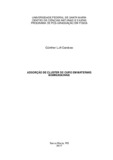| dc.creator | Cardoso, Günther Luft | |
| dc.date.accessioned | 2018-07-26T19:03:11Z | |
| dc.date.available | 2018-07-26T19:03:11Z | |
| dc.date.issued | 2017-07-31 | |
| dc.identifier.uri | http://repositorio.ufsm.br/handle/1/13929 | |
| dc.description.abstract | In this work, we studied the interaction of Au34 gold cluster with different two-dimensional
materials. Au clusters, differently of their macroscopic form, are chemically reactive. Their
use requires substrates. The two-dimensional materials chosen as substrates were graphene,
tungsten diselenide and boron nitride. Besides this, we studied the interaction of Au34 cluster
with defective graphene (vacancy) and tiophenol functionalized graphene. These materials
were chosen due the differences among their physical properties, and the facility one
can obtain monolayers out of these materials. The tiophenol functionalized graphene were
utilized because it is experimentally verified that this material is a good catalyst, and it is
efficient to anchor gold clusters, avoiding them to agglomerate in aggregates with lower
surface/volume ratio, fact that diminishes the efficiency of chemical reactions that needs
catalysts. The gold cluster chosen possess 34 atoms because this is one of the magical
numbers for cluster of this element. The most stable configuration for this gold cluster
has C3 symmetry, with diameter around of 0.8 nm. All calculations were performed using
the density functional theory with the gradient generalized approximation for the exchange
and correlation functional, as implemented in the code VASP. We determined the bond
energies, structural distortions and charge exchange between the interacting systems and
analyzed the electronic structures through their density of states. Our results indicates that
the gold cluster practically don’t interact with the graphene and boron nitride sheets. The interactions
of cluster with tiophenol funcionalized graphene and tungsten diselenide showed
higher bond energies, while the interactions with defective graphene showed intermediate
bond energy. The active sites for electrophilic and nucleophilic reactions are localized in
the gold atoms, with active sites in the substrate being inactive due steric hindrance. The
chemically active systems, with the gold clusters attached in the substrate and amphoteric
behavior presents different values of energy gap, allowing their use in different chemical
environments. | eng |
| dc.description.sponsorship | Coordenação de Aperfeiçoamento de Pessoal de Nível Superior - CAPES | por |
| dc.language | por | por |
| dc.publisher | Universidade Federal de Santa Maria | por |
| dc.rights | Attribution-NonCommercial-NoDerivatives 4.0 International | * |
| dc.rights.uri | http://creativecommons.org/licenses/by-nc-nd/4.0/ | * |
| dc.subject | Cluster | por |
| dc.subject | Materiais bidimensionais | por |
| dc.subject | Energia de ligação | por |
| dc.subject | Catálise | por |
| dc.subject | Cluster | eng |
| dc.subject | Bidimensional material | eng |
| dc.subject | Bond energy | eng |
| dc.subject | Catalysis | eng |
| dc.title | Adsorção de cluster de ouro em materiais bidimensionais | por |
| dc.title.alternative | Adsorbtion of gold gluster in two-dimensional materials. | eng |
| dc.type | Dissertação | por |
| dc.description.resumo | Neste trabalho estudamos a interação do cluster de ouro Au34 com diferentes materiais
bidimensionais. Clusters de Au, diferentemente do seu comportamento na forma macroscópica,
são reativos quimicamente. Sua utilização requer a deposição em substratos.
Os materiais bidimensionais escolhidos como substrato foram o grafeno, o disseleneto de
tungstênio e o nitreto de boro. Além disto, estudamos a interação do cluster de Au34 com
o grafeno com defeito (vacância) e o grafeno funcionalizado por tiofenol. Estes materiais
foram escolhidos devido às diferenças entre as suas propriedades físicas e, sobretudo, na
facilidade em que se pode obter monocamadas destes materiais. O grafeno funcionalizado
por tiofenol foi utilizado pois verifica-se experimentalmente que este material é um
bom catalisador, e é eficiente em ancorar os clusters de ouro, evitando a aglomeração
destes em agregados de menor razão superfície/volume, o que diminui a eficiência das
reações químicas que necessitam catalisador. O cluster de ouro escolhido possui 34 átomos
pois este é um dos números mágicos para clusters deste elemento. A configuração
mais estável para este cluster de ouro possui simetria C3, com o diâmetro em torno de 0,8
nm. Todos os cálculos foram feitos utilizando a teoria do funcional da densidade dentro
da aproximação do gradiente generalizado para o funcional de troca e correlação, como
implementado no programa computacional VASP. Determinamos as energias de ligação,
as distorções estruturais, as trocas de carga entre os sistemas interagentes e analisamos
as estruturas eletrônicas através das densidades de estados. Nossos resultados indicam
que o cluster de ouro praticamente não interage com as folhas de grafeno e nitreto de boro.
As interações do cluster com o grafeno funcionalizado por tiofenol e com o disseleneto de
tungstênio mostraram as maiores energias de ligação, enquanto a interação com o grafeno
com defeito (vacância) apresenta uma energia de ligação intermediária. Os sítios ativos
para as reações eletrofílicas e nucleofílicas estão localizados nos átomos de ouro, com
os sítios ativos no substrato sendo inativados por impedimentos estéricos. Os sistemas
quimicamente ativos, com os clusters de ouro fixados no substrato e um comportamento
anfotérico, apresentam diferentes valores de gap de energia, permitindo a sua utilização
em diferentes ambientes químicos. | por |
| dc.contributor.advisor1 | Piquini, Paulo Cesar | |
| dc.contributor.advisor1Lattes | http://lattes.cnpq.br/4496249071363237 | por |
| dc.contributor.referee1 | Dorneles, Lucio Strazzabosco | |
| dc.contributor.referee1Lattes | http://lattes.cnpq.br/7244173039310066 | por |
| dc.contributor.referee2 | Santos, Cláudia Lange dos | |
| dc.contributor.referee2Lattes | http://lattes.cnpq.br/8097034095042937 | por |
| dc.creator.Lattes | http://lattes.cnpq.br/3054558744787074 | por |
| dc.publisher.country | Brasil | por |
| dc.publisher.department | Física | por |
| dc.publisher.initials | UFSM | por |
| dc.publisher.program | Programa de Pós-Graduação em Física | por |
| dc.subject.cnpq | CNPQ::CIENCIAS EXATAS E DA TERRA::FISICA | por |
| dc.publisher.unidade | Centro de Ciências Naturais e Exatas | por |



